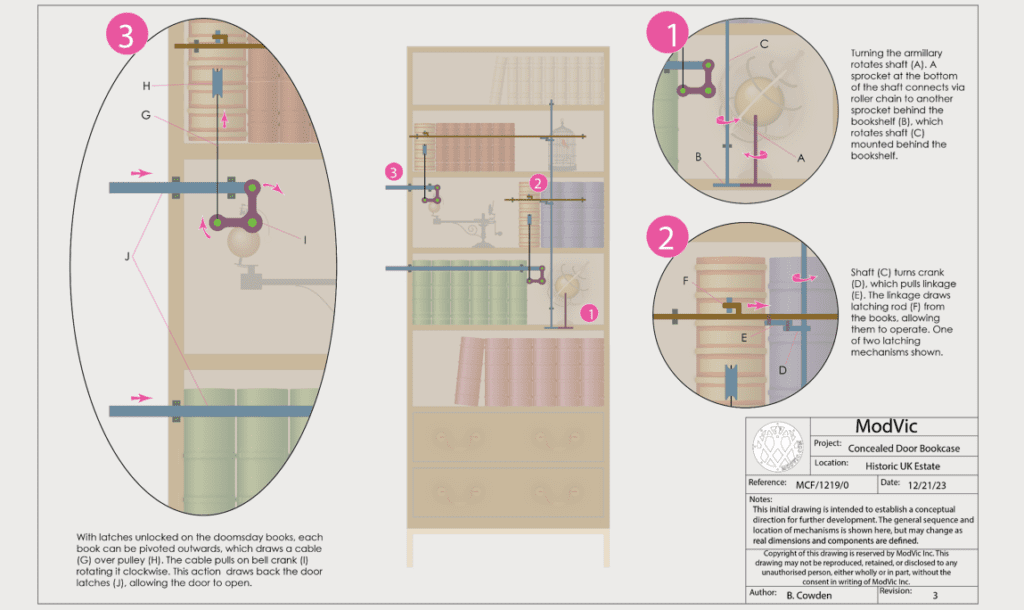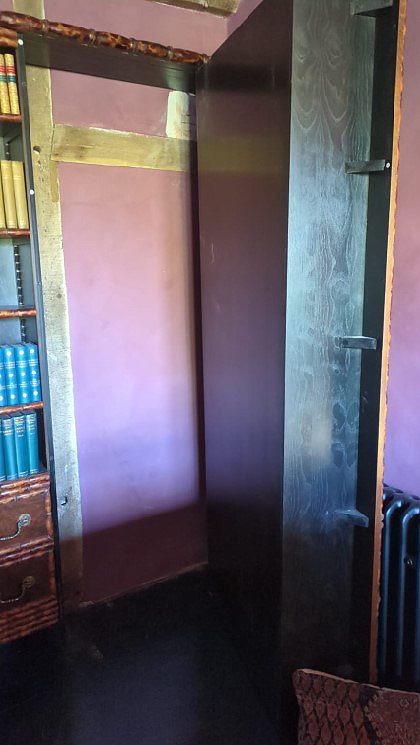

Bruce Rosenbaum and Jeremy Griswold team up to design and fabricate a bespoke 3-step mechanical system to unlock a door hidden behind a bookcase

In the spirit of “Bruce Wayne meets James Bond” – one must turn an armillary 180° and tip 2 Domesday Books in the proper order to release the latch that reveals… another doorway that is “Hobbit size” (but that’s another tale).
Hidden doors are nothing new, but making a puzzle out of the latch mechanism is a new twist on a familiar idea.
Design challenges
Although it’s incredibly complex to fabricate an interacting, sequenced system, for this project the working components had to appear simple and be hidden from view.
To complicate things further, after the mechanical system ran sequentially it had to reset because the door had to be easily opened in a single step when exiting the passageway.
Oh, and did we mention no electronics or electrical system were permitted?
Needless to stay several prototypes had to be made, tested, refined, and remade at each step to build a robust and long-term working system.
Other Details
The last big hurdle was what we called “hiding the hinges”. To preserve the illusion, the user must not see how the device works. The hinged books required a custom-made solution in order that they can be tilted down to effectively lift the latch while showing no visual signs that the hinge is there.
The solution required us to hollow out and reinforce books to effectively hide a 4-bar linkage, which allowed us to tilt both forward and down.
Installation
Since our device would be installed to an existing bookcase across the Pond, at a noted historic estate just outside of London, UK, the goal was to make the process as easy as possible.
The majority of the assembly was built on a large metal plate that could be attached to the back of the bookcase. Several holes had to be drilled for the cables that run to the faux books. Hinges had to be screwed to the existing shelves – but otherwise, no alterations were needed.
We also provided an instruction guide with drawings, as well as a one-hour step-by-step video narrated by project designer Jeremy Griswold, who personally fabricated and tested all of the aluminum components.


In 1085, King William I (a.k.a. William the Conqueror) commissioned a survey of all his British land holdings including much of England and parts of Wales, in order that he may track and account for the dues owed him.
A manuscript of the survey’s findings, named “The Book of Winchester”, was first published a year later in 1086 – and has been continuously maintained ever since as a tax record from the early estates of the Dark Ages through the era of Elizabethan manors and homesteads.
The manuscript was later named the Domesday Book, which Americans would pronounce “doomsday”. In a nod to ironic tradition, these are the volumes on the bookshelf often used to trigger a hidden door!





